-
Promising geothermal resources found on Akutan Island, Alaska
Akutan Island, in Alaska’s east-central Aleutian Islands, hosts the City of Akutan and is home to the largest seafood production facility in North America. It also hosts Akutan Volcano, one of the most active volcanoes in the United States. During July 2012 the geochemistry of the hot springs on Akutan Island was studied in detail for the first time since the early 1980s. The results from this study document higher concentrations of hydrothermal components in the hot spring waters and an increase in water discharge from the hot spring system. The current heat output of the hot spring system is estimated at twenty-nine megawatts — nearly ten times higher than measured in the early 1980s. This large increase may reflect the volcanic and seismic events of the 1990s, and if so, it cannot be considered a short-term anomaly. Modern geothermal plants could use this heat to generate several MW of electricity. One MW of electric power would supply the needs of about 750 homes.
-
-
Torrential rain, hurricane-force winds, floods continue to batter U.K.
Torrential rains, floods, and winds with speeds reaching 108 mph continue to batter south and west U.K., causing massive disruptions to power supply and road and rail transportation. Britain is enjoying a short respite today (Thursday), but meteorologists warned people to brace themselves for more chaos as another storm brings heavy rain, strong winds, and more risk of flooding on Friday and into the weekend. Severe flood warnings, indicating danger to life, remain in place in Berkshire, Surrey, and Somerset, where hundreds of homes have been evacuated.
-
-
W.Va. spill leads lawmakers, industry to look at reforming toxic substances law
The government was slow to respond to the 9 January 2014 massive chemical spill in West Virginia because the law governing such response, the 1976 Toxic Substances Control Act (TSCA), limits regulatory agencies’ authority to investigate such spills.Under TSCA, the EPA must first prove that a chemical poses an unreasonable risk to health or the environment before it can require the needed testing that would show a potential risk. One observer called this a Catch-22, telling a congressional panel that “This is like requiring a doctor to prove that a patient has cancer before being able to order a biopsy.”
-
-
Floods caused lead poisoning in U.K. cattle
Massive floods in England and Wales have forced thousands to evacuate their homes and destroyed railways and roads. Scientists say the U.K. floods of recent years carry yet another danger with them: lead poisoning. Silage cut from fields soon after they were inundated in the 2012 floods and then fed to cattle raised the lead levels in the animals, killing some of them. Blood samples taken from cattle showed that all of them had lead levels beyond the safe limit for human consumption. An autopsy carried out on one of the casualty animals found lead concentrations 79 times the safe level in its kidney. The contaminated material is thought to originate from historical metal mining in the area. Scientists say a number of river catchments throughout England and Wales face a similar risk.
-
-
Natural gas leaks a significant source of green-house gas methane

Methane, a key greenhouse gas, has more than doubled in volume in Earth’s atmosphere since 1750. Its increase is believed to be a leading contributor to climate change. Where is the methane coming from, however? Research by atmospheric chemist Paul Wennberg of the California Institute of Technology (Caltech) suggests that losses of natural gas – regarded as the “cleanest” fossil fuel — into the atmosphere may be a larger source than previously recognized.
-
-
U.K. facing flood crisis, as prime minister warns victims they are in for “long haul”
David Cameron warns flooding victims that they are in for a “long haul,” as the weather service says the weather will get worse this week, leaving thousands more homes at risk. There is a growing anger at the government by residents who complain that in addition to lack of preparation and response – thus, there were many complaints that sandbags intended for the worst-hit areas being “hijacked” and unavailable to stem the rising water – government agencies have not provided enough security after resident were ordered to evacuate, leading to looting of vacant homes. Officials have predicted that thousands more homes will be flooded over the coming days and said restoring the country’s battered rail network could take months.
-
-
More than 60 percent of California suffers drought conditions, with no relief in sight
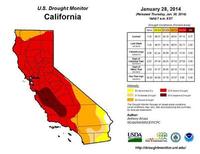
The entire west coast of the United States is changing color as the deepest drought in more than a century unfolds. According to the U.S. Department of Agriculture and NOAA, dry conditions have become extreme across more than 62 percent of California’s land area — and there is little relief in sight. “Up and down California, from Oregon to Mexico, it’s dry as a bone,” say a NAA scientist. “To make matters worse, the snowpack in the water-storing Sierras is less than 20 percent of normal for this time of the year.”
-
-
Coastal areas must adapt to sea-level rise and storm surges or suffer massive damage
A new study presents, for the first time, comprehensive global simulation results on future flood damages to buildings and infrastructure in coastal flood plains. Drastic increases in these damages are expected due to both rising sea levels and population and economic growth in the coastal zone. Asia and Africa may be particularly hard hit because of their rapidly growing coastal mega-cities, such as Shanghai, Manila, and Lagos.
-
-
Quake-vulnerable concrete buildings in Los Angeles area identified
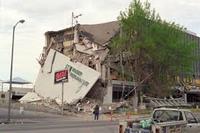
Researchers have identified nonductile concrete buildings constructed before roughly 1980 in the Los Angeles area. This category of buildings is known from experience in previous earthquakes to have the potential for catastrophic collapse during strong earthquakes. Nonductile concrete buildings were a prevalent construction type in seismically active zones of the United States before the enforcement of codes for ductile concrete which were introduced in the mid-1970s. A companion study estimates that approximately 17,000 nonductile reinforced concrete buildings are located in the most highly seismic areas of California. More than seventy-five million Americans in thirty-nine states live in towns and cities at risk for earthquake devastation.
-
-
New research on ocean conditions to aid Navy planners

The Office of Naval Research Global (ONR Global) announced last week a grant to the University of Melbourne which will provide new insights into ocean conditions — crucial information for Navy planners involved in tactical and strategic decision-making. The goal of the effort is to provide the best information possible on the environmental, or battlefield, conditions, so that tactical and strategic decisions can be properly made.
-
-
Protecting cities from floods cheaper than post-flood damage repairs

Researchers say that global warming is here to stay, and thus it is time to start making plans for dealing with the inevitable flooding which will occur as ocean levels rise as a result of warmer water and melting snow and ice. Approximately a billion people currently live in areas which are most at risk — low-lying coastal areas. It is not likely that towns and cities will be moved farther inland, so other measures need to be taken. The researchers say that flood prevention strategies are well established, for example, building levees, barrier islands, etc., so it is not difficult to draw up estimates for such schemes for individual areas.
-
-
Total California water supplies at near-decade low
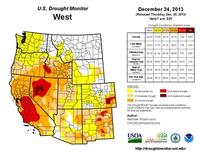
Advisory from UC Center for Hydrologic Modeling finds California’s statewide averages of snow, surface water, and soil moisture near 10-year lows. The threat of multi-year period of unsustainable groundwater depletion imminent if drought continues. The data show particularly steep water losses between November 2011 and November 2013, the early phase of the current drought. The researchers estimate that the Sacramento and San Joaquin River basins have already lost ten cubic kilometers of fresh water in each of the last two years — equivalent to virtually all of California’s urban and household water use each year.
-
-
Eco-terrorist sentenced to five years and ordered to read Malcolm Gladwell’s book
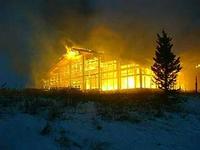
Last Monday, Chief U.S. District Judge Ann Aiken imposed a 5-year sentence on radical environmental activist Rebecca Rubin for her involvement in several acts of arson, including the burning of Vail Colorado’s Twin Elks Lodge which caused millions of dollars in damage. Rubin spent almost eight years living underground, giving herself up to the FBI last October. She pleaded guilty to arson, attempted arson, and conspiracy to commit arson in connection with a radical environmental group calling itself The Family. Judge Aiken also ordered Rubin to read Malcolm Gladwell’s 2013 book David and Goliath, explaining that Rubin might learn a thing or two about non-violent environmental advocacy while serving her sentence.
-
-
Senegal climate change-induced flooding reaching crisis proportions: UN
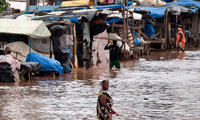
Margareta Wahlstrom, the head of the UN disaster risk, last week warned that climate change-induced flooding had reached crisis proportions in Senegal, with some towns and villages now finding themselves underwater for large parts of the year. Wahlstrom, who was in Senegal for a 3-day visit as part of the UN preparations for a new global disaster risk-reduction strategy, said that mayors of coastal and riverside towns and villages told her their streets were flooded ten months out of twelve.
-
-
Clouds influence how greenhouse gases affect climate
The warming effect of human-induced greenhouse gases is a given, but to what extent can we predict its future influence? That is an issue on which science is making progress, but the answers are still far from exact, say researchers. Indeed, one could say that the picture is a “cloudy” one, since the determination of the greenhouse gas effect involves multifaceted interactions with cloud cover.
-
- All
- Regional
- Water
- Biometrics
- Borders/Immig
- Business
- Cybersecurity
- Detection
- Disasters
- Government
- Infrastructure
- International
- Public health
- Public Safety
- Communication interoperabillity
- Emergency services
- Emergency medical services
- Fire
- First response
- IEDs
- Law Enforcement
- Law Enforcement Technology
- Military technology
- Nonlethal weapons
- Nuclear weapons
- Personal protection equipment
- Police
- Notification /alert systems
- Situational awareness
- Weapons systems
- Sci-Tech
- Sector Reports
- Surveillance
- Transportation
Advertising & Marketing: advertise@newswirepubs.com
Editorial: editor@newswirepubs.com
General: info@newswirepubs.com
2010-2011 © News Wire Publications, LLC News Wire Publications, LLC
220 Old Country Road | Suite 200 | Mineola | New York | 11501
Permissions and Policies
Editorial: editor@newswirepubs.com
General: info@newswirepubs.com
2010-2011 © News Wire Publications, LLC News Wire Publications, LLC
220 Old Country Road | Suite 200 | Mineola | New York | 11501
Permissions and Policies
